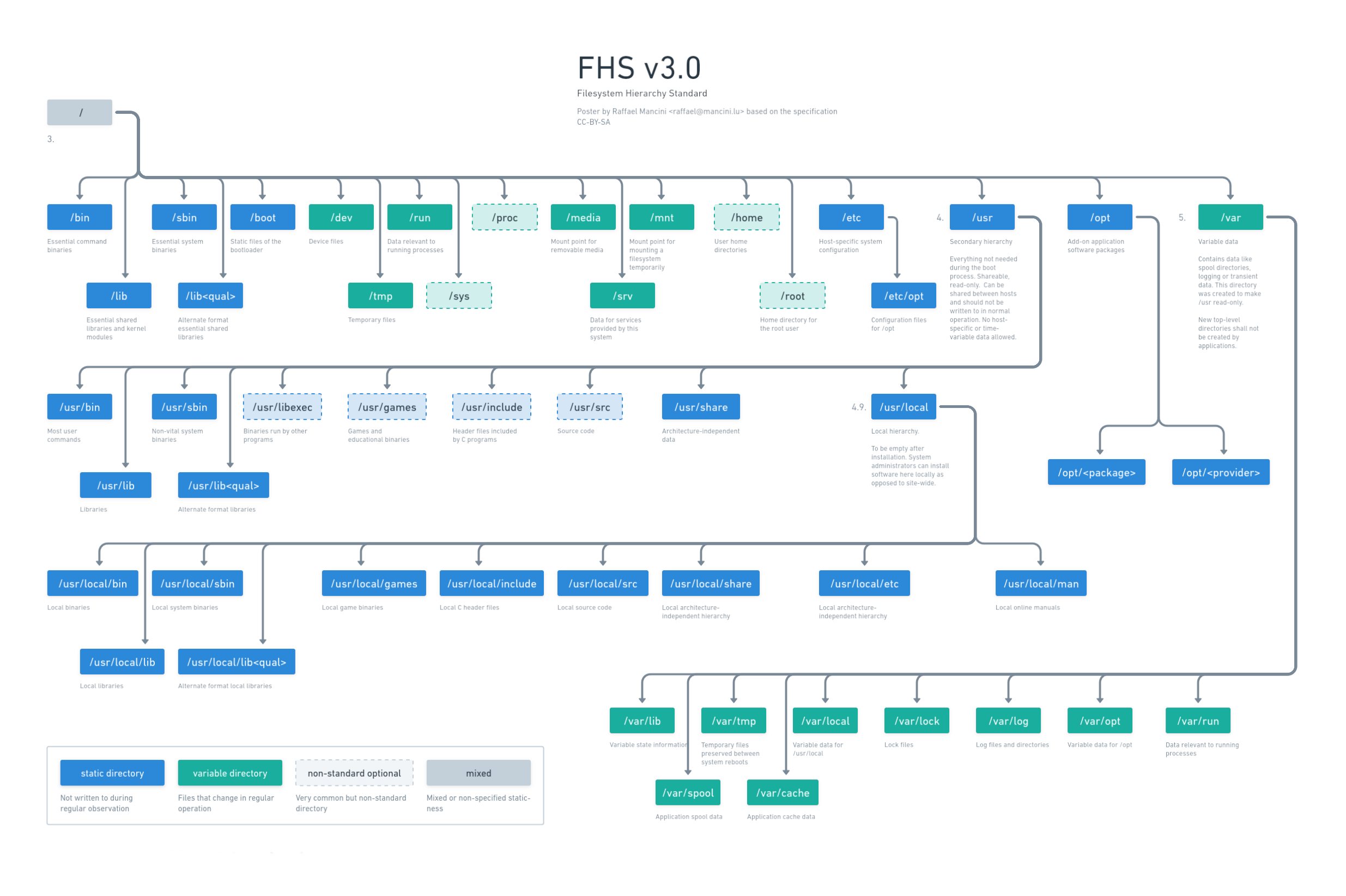Hey, I’ve recently designed a Poster about the FHS since I often forget where I should place or find things. Do you have any feedback how to make it better?
I updated the poster: https://whimsical.com/fhs-L6iL5t8kBtCFzAQywZyP4X use the link to see online.

Dark mode

Old version
deleted by creator
Done!
Damn that’s some great work ! When I started linux I wish I had found such ressources, I was really curious what each of these directories were for.
Would you mind if your material was reused (with credit) for education purposes ?
I’d be more than happy if this was used. Do whatever you want with it as long as you abide by the CC BY-SA-4.0 license. This means you can share freely and modify as long as you keep the authorship information and share with same license.
The FHS was started in 1994 and is free to use. It should be used now by all major Linux systems and most Unix too.
The only credit is to the Linux Foundation.
Material visualising or describing FHS can be credited seperatly.
But $vendor, which supplies $application, doesn’t give a flying fuck about this. I’ve seen binaries in /etc/opt/$application or something like that.
Tell them. Many people don’t know about FHS. Seriously, just the person I was answering to was giving credit to some rando who copy pasted an image from the Linux foundation.
I’ve been educating people on this all my professional life. I try to make a change with the people around me, but I’ve also filed big to some FOSS projects that got it wrong. Some did the change, some were unwilling. But it’s unknown if even those did follow the right convention in their next project.
I spent a few hours making it myself. Of course based on the standard document.
deleted by creator
You leave NixOS alone!!
ikr? NixOS is particularly bad
That’s a deliberate decision
Related:
man hierit bothers me a little the entry is not called
fhs:man fhsAdded to new version. Thanks for the suggestion.
Where should I mount my additional internal HDD’s?
/media doesn’t fit cause they aren’t removable
/mnt doesn’t fit cause they aren’t mounted temporarily
Currently I have them mounted as /home/user/data and /home/user/backup.
Any reason not to do it like this?I just mount mine into /mnt and bind mount subdirectories from them into wherever I need the space.
Edit: if you want a more theoretically correct location according to the FHS you could mount drives somewhere under /run and bind their contents from there. I’ve done that before as well.
tbh I don’t think it matters, so wherever you feel like doing it. I just leave it where the distro or file manager defaults to: in Ubuntu-based distros that’s
/media/$USER/mount-name. For mounts shared across users you could drop the$USER.Since FHS doesn’t specify where “non-removable media” should go, I don’t think it makes sense to adopt this recommendation as
/mediashould be removable, but rather, “in case the media IS removable, then mount it to/media/”.If they are internal and permanent (read: unlikely to be removed on a daily basis), I’d just mount them based on their purpose and not them being separate HDDs physically. If they are meant for logs, mount them at /var/log. If they are meant for your movies, /home/user/data is more than fine. In general FHS describes the directory hierarchy, not which parts of it are mountpoints and which are physically on the same media. Technically you’re fine having each and every directory on a separate HDD.
I’m also mounting them into /home/user/data while I don’t think hard-coding the user name in the mountpoint is a good idea. Besides, it needs the assumption that I’m the only “human-user” of this computer.
I may also mount them at /opt/data, but I’m not sure if it’s a good idea
From my humble knowledge I would suggest /var/opt/XXX. It’s the variable part of the /opt hierarchy.
I originally had mine mounted on
/, to make them easy to type. But that set one of my highly opinionated friends wretching, so I re-mounted them to/media//to placate him and symlinked them to my home directory instead.It’s frustrating how often Linux systems, when approached with a “where is the canonical location for ?” question, have an answer ancient use cases practically no one has anymore, but no satisfying answer for extremely common use cases like permanently mounted backup drives, where to put web server hosted files, or even where to install applications that don’t come from package managers (
/opt/?/usr/bin/?/home//.local/?).Just put all of that in subfolders of /fuck_the_FHS/
I’m coming more from a server perspective but, fundamentally, all HDDs are “temporary”. Eventually that data might be in a bigger/faster/functioning replacement - so it’s best to treat the drive as something which can always be replaced.
Continuing that, you might mount to /mnt and then symlink that where you really want it, say …/games. That layer of abstraction allows you to replace the drive without much effect on install. Also allows for expansion via something like mergerfs (*no idea if that’s a good idea for your use cases)
/mnt is explicitly meant to be used as temporary mountpoint for admins. That’s not a good place.
I’m still learning myself, but I think in a good number of uses cases it qualifies. There are two parts of that explicit definition which seem important, “temporary” and “non-installation”. “Temporary” is the most ambiguous. An array of JBoD storing media files, which can be unplugged really at any time without affecting any system, meets that definition. Game installs or the operating system, less so. I totally get my specific usage may not lend to generic advice. In the interest of me learning, here’s where I started (which advises /mnt): https://perfectmediaserver.com/02-tech-stack/mergerfs/
If it’s just personal files and backups, there’s absolutely nothing wrong with what you’re doing.
If you had, say, active system config files there, it would make things… complicated to say the least.
deleted by creator
Usb devices are nowadays when connected mounted somewhere in /run/%user
I really like this, but can I have a black background version please?
Added a black background version.
Not bad, but not quite what I had in mind as you see the blue carrot, lol. Would you perhaps share your project files?
I unfortunately did it in whimsical.com which is great but also closed if you don’t pay. https://whimsical.com/fhs-L6iL5t8kBtCFzAQywZyP4X is the best I can do.
You could create a Github repo for it and store it as an SVG file.
You could invert the colors in GIMP or similar.
That wouldn’t look as good tho. I want the black text to be white and the white background to be black not invert everything.
Super useful, thanks. Actually made a lot of things click in my head about how Linux works.
When did /home get deprecated? Is /usr/local the replacement?
Sorry for the n00b question (I’m not a noob, but I have been off Linux for a few years), figured the answer may be useful to other users too
/home is not deprecated, it’s optional but common. Here is the section from FHS: https://refspecs.linuxfoundation.org/FHS_3.0/fhs/ch03s08.html
then the legend should be fixed its confusing, as is the whole idea of FHS is outdated and a chore for new users to get into (i still don’t fully understand it)
- difference between /media and /mnt
- wtf is /run? some glorified /temp?
- /usr/sbin “non vital system binaries” … aha ok, whatever don’t tell me you understand the difference between 6 (SIX !) differen bin/sbin folders
- could continue forever…
The legend is a bit broken. Will fix it maybe.
As for the rest, yes, the FHS can be confusing. It’s from a time where mostly professional admins would deal with it and requirements were pretty different from today’s end-user systems. If you want to understand more, I urge you to read the spec. It’s highly readable! https://refspecs.linuxfoundation.org/FHS_3.0/fhs.html
/mnt is for more permanent stuff. /run is for shit like a USB drive some user has connected. It’s the place that most distro automount your attached storage by default (/run/$USER/$DEVICE/)
We need something like this for home, I hate that programs like steam and firefox place themselves directly into home instead of ~/.config and ~/.llocal.
I even move my personal themes to /usr/share/themes because not everything works with ~/.local/share/themes and needs a ~/themes directory instead.
My personal pet peeve is that Firefox profiles are in
~/.mozilla/firefoxand Thunderbird profiles are in~/.thunderbird.
If your flagship product creates a folder named after your company, why not use it for all software by your company???Thunderbird isn’t really developed by Mozilla any more. It’s owned by a subsidiary of Mozilla and is mostly community-run.
Thanks, I just went down this rabbit hole and discovered xdg ninja and managed to clean most of my home, I even found a useful script that launches steam on a fake home directory on .local.
Uhh, very nice. I didn’t know about xdg-ninja.
I don’t understand the ambiguity of where to put your projects.
I’ve typically always put things under /opt/ TIL /etc/opt was where the config should go.
Depends on the scope of your project. But if they are services for example or you want them to be run by different users on the system, you could either use /opt or /usr/local. There is some discussion about which is better or how to choose: eg. https://www.linuxjournal.com/magazine/pointcounterpoint-opt-vs-usrlocal . The FHS is mostly relevant when packaging your software though.
Less relevant with Docker or FlatPaks though right?
I’m not into those since they just shift the complexity. People should learn how to package things and just do it. Ok, documentation on making dpkgs is pretty tough to understand and confusing.
But yeah, I guess with docker it’s complete anarchy ( the bad kind of)
But yeah, I guess with docker it’s complete anarchy ( the bad kind of)
Not really, usually stuff will be all self contained (no pun intended), container volumes inside docker’s own directory and mounts of folders that will most often all reside under the same repository, then you don’t have to worry about breaking stuff by touching the root, even better if you do that with Podman.
Flatpak is similar in the way that it also has its own standards and apps are pretty much obligated to follow them. Now the fact that data lives under
.var/app/completely disregarding the XDG spec, while both things are part of Freedesktop… Well that’s just ironic lolBut who knows what’s inside?
Not at all true. Go inspect the Dockerfile. If done correctly you should be able to inspect the full container build.
Of course you can, but few people care and do it. There is a saying about docker: “Docker images are like smoothies, you immediately know if you like it but you don’t know what’s inside”. The idea being that there is no good quality control and transparency. People just install random blobs, like in the old days where you would install a cracked game from eMule.
If you care about security, docker is not what you want, they are not reproducible nor transparent nor is it possible to easily update broken shared libraries (eg openssl).
But then again people have different requirements. Some just wanna have things running quickly without the hassle. That’s where docker shines. But it leads us to a world where we hide ugly stuff under the carpet instead of fixing things.
This is a very useful, very well done chart, congratulations.
But what a mess is FHS. Easily the worst thing of linux design for me
The better you understand it the less it seems bad.
I’m surprised to hear /home is non standard.
I guess the reason it’s not in FHS is that FHS is concerned about system wide things whereas /home is the opposite. It’s the user’s realm.
There is XDG for /home/$user though.
Are you planning on doing one for XDG?
I’ll have a look but probably not.
laughs in guix
does guix go the same was as nixos in that regard? where can I find info regarding FHS in guix?
Afaik guix is very similar to nixos in that respect. The store where applications are installed is called /gnu there.
yeah it uses /gnu instead of /nix
FHS? Who needs that?
Great but what I’m missing is the information that “usr” does not stand for “user”, like many people think or even say. If it would the name could actually be “user” and not “usr”.
The chart actually does not say what exactly it stands for. It’s “user resources” AFAIK.
It’s worth clearing this up in my opinion.
Thanks for the input. Things are complicated: https://askubuntu.com/a/135679 . Apparently it originally meant “user” but then slowly was used for system stuff. So people invented backcronyms.
That’s just retconning/backronyming it.
/usr does historically stand for user. It’s where the user home directories were on old Unix versions.
how is /usr/local local and not system-wide? i though it was for programs you compiled yourself?
“Local” in this context means local to this whole machine. From the perspective of a single user, it’s system-wide. But then from the perspective of a sysadmin managing dozens of such systems, it’s local.
thanks for the explanation!
Many FHS things don’t make much sense for single-user (human user) systems on modern hardware. /usr/local does though. It’s for you (as admin) to install software that doesn’t come with the os.
Nicely done! Do you perchance have any hi res version?
Thanks! Unfortunately I’ve used closed source whimsical.com for this and don’t have a paid subscription. They only offer low-res for those accounts since recently :(
Maybe try to do inkscape?
Maybe some AI upscaling could do the trick ?
perchance

















